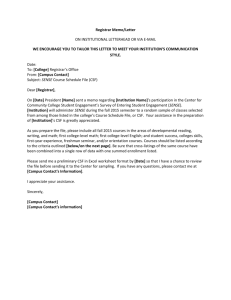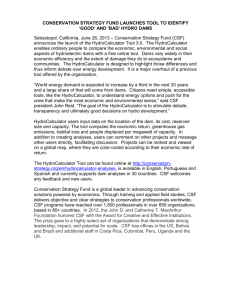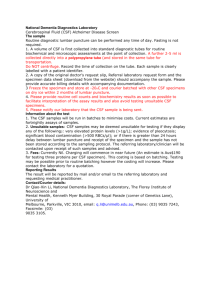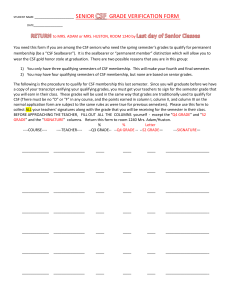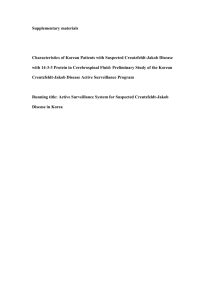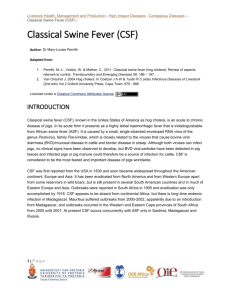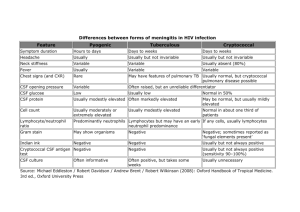Biological Protocol
advertisement
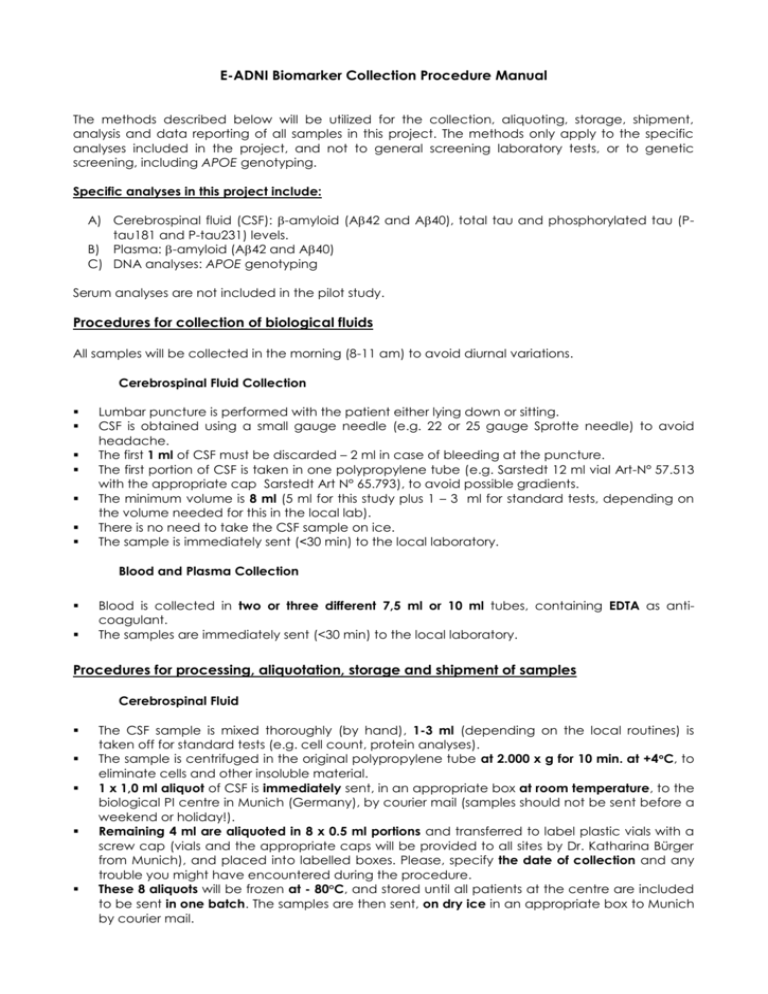
E-ADNI Biomarker Collection Procedure Manual The methods described below will be utilized for the collection, aliquoting, storage, shipment, analysis and data reporting of all samples in this project. The methods only apply to the specific analyses included in the project, and not to general screening laboratory tests, or to genetic screening, including APOE genotyping. Specific analyses in this project include: A) Cerebrospinal fluid (CSF): -amyloid (A42 and A40), total tau and phosphorylated tau (Ptau181 and P-tau231) levels. B) Plasma: -amyloid (A42 and A40) C) DNA analyses: APOE genotyping Serum analyses are not included in the pilot study. Procedures for collection of biological fluids All samples will be collected in the morning (8-11 am) to avoid diurnal variations. Cerebrospinal Fluid Collection Lumbar puncture is performed with the patient either lying down or sitting. CSF is obtained using a small gauge needle (e.g. 22 or 25 gauge Sprotte needle) to avoid headache. The first 1 ml of CSF must be discarded – 2 ml in case of bleeding at the puncture. The first portion of CSF is taken in one polypropylene tube (e.g. Sarstedt 12 ml vial Art-N° 57.513 with the appropriate cap Sarstedt Art N° 65.793), to avoid possible gradients. The minimum volume is 8 ml (5 ml for this study plus 1 – 3 ml for standard tests, depending on the volume needed for this in the local lab). There is no need to take the CSF sample on ice. The sample is immediately sent (<30 min) to the local laboratory. Blood and Plasma Collection Blood is collected in two or three different 7,5 ml or 10 ml tubes, containing EDTA as anticoagulant. The samples are immediately sent (<30 min) to the local laboratory. Procedures for processing, aliquotation, storage and shipment of samples Cerebrospinal Fluid The CSF sample is mixed thoroughly (by hand), 1-3 ml (depending on the local routines) is taken off for standard tests (e.g. cell count, protein analyses). The sample is centrifuged in the original polypropylene tube at 2.000 x g for 10 min. at +4C, to eliminate cells and other insoluble material. 1 x 1,0 ml aliquot of CSF is immediately sent, in an appropriate box at room temperature, to the biological PI centre in Munich (Germany), by courier mail (samples should not be sent before a weekend or holiday!). Remaining 4 ml are aliquoted in 8 x 0.5 ml portions and transferred to label plastic vials with a screw cap (vials and the appropriate caps will be provided to all sites by Dr. Katharina Bürger from Munich), and placed into labelled boxes. Please, specify the date of collection and any trouble you might have encountered during the procedure. These 8 aliquots will be frozen at - 80°C, and stored until all patients at the centre are included to be sent in one batch. The samples are then sent, on dry ice in an appropriate box to Munich by courier mail. Blood and Plasma One blood sample in 10 ml vial is not centrifuged, and is used for DNA extraction and ApoE genotyping, provided by local laboratory. The other blood sample for plasma is mixed thoroughly, and then centrifuged at 2.000 x g for 10 min. at +4C. The supernatant is pipetted off. One 1,0 ml aliquot of plasma is immediately sent, in an appropriate box at room temperature, to the biological PI centre in Göteborg (Sweden), by courier mail (sample should not be sent before a weekend or holyday!). 8 x 0,5 ml aliquot of plasma are transferred to labelled plastic vials with a screw cap (e.g. Nalgene Cryogenic 1.0 ml vials #5000-1012), and placed into labeled boxes. Please, specify the date of collection and any trouble you might have encountered during the procedure. These 8 aliquots of plasma are frozen at - 80°C, and stored until all patient at the centre are included to be sent in one batch. The samples are then sent, on dry ice in an appropriate box, to Göteborg by courier mail. Procedures for analysis of samples When received in the Laboratory, at the biological PI centres, the samples will be stored at -80C until analysis. The freezer will be equipped with an alarm system for electrical power failure or temperature increase, with 24h access to technical staff at the hospital. Extra freezers are available for emergency use. The aliquots sent by RT are frozen and stored at -80C until the study is completed. Both the RT and the -80C aliquot are analyzed side by side on the same plate. A database will be created over the samples, to facilitate correct identification. The database will contain the following information: sample ID, centre, date of collection, date of receival, total initial volume for each sample type (CSF, plasma), freezer, and rack-box location in the freezer. A bar code label will be used on the sample tracking form that is used by the technologist when processing samples. For the analyses, established, validated ELISA methods are used. For standardization of measurements between different runs, 3 internal controls of pooled CSF are run on each ELISA plate assayed. These control samples consists of: 1) pooled CSF with normal T-tau, P-tau and A42 2) pooled CSF with high T-tau and P-tau but normal A42 3) pooled CSF with low A42, but normal T-tau and P-tau The same type of internal control samples is used for plasma measurements. Data from the analyses will be entered into a database also containing information about assay characteristics and internal control levels. For APOE genotyping, DNA is extracted from whole blood using a standardized, automated method, and APOE genotyping is performed using minisequencing, which is an established, and published method. These analyses will be provided by local laboratories. Naming convention of sample identification General scheme – XX_YYY_Z XX – site number Site numbers are according to the following list: No. 01 02 03 04 05 06 07 Site name Copenhagen Stockholm Toulouse Munich Brescia Rome Amsterdam Country Denmark Sweden France Germany Italy Italy Netherlands YYY – subject number Cumulative number of a subject, to be appointed by site 001 = First subject 002 = Second subject etc. Z – material Following codes for different materials will be used: M – Magnetic Resonance Imaging Samples C – Cerebrospinal Fluid Samples P – Plasma samples EXAMPLE: 07_002_C – this will be the CSF sample of the second patient from the Amsterdam site. The CSF and blood (plasma) samples numbering doesn’t contain the diagnosis identification and sample number. Please, make sure that ANY STRICTLY UNAVOIDABLE VARIATION from the lines of this protocol is accurately specified on a form attached to the samples!!! Appendix 1 – Scheme of CSF samples handling 1 – 2 ml of CSF ≈ 8 ml of CSF discarded in a 12,0 ml vial* Subject’s back NOT CENTRIFUGED ≈ 1 – 3 ml of CSF for routine lab tests if needed Rest of 5 ml of CSF Centrifuged 10 minutes +4 °C 2000 x g 1,0ml of CSF in 1,0ml vial* 4 ml of CSF aliquoted in: 8 vials* x 0,5ml portions Remaining CSF shipped immediately at room temperature to Munich (Germany) stored locally at – 80°C sent later on dry ice in one batch to Munich (Germany) Used for local purposes (not for Pilot E-ADNI) * The vials for CSF samples will be provided by Dr. Katharina Bürger from Munich center (Germany) Appendix 2 – Scheme of blood and plasma samples handling 5,0 ml of blood Subject’s arm NOT CENTRIFUGED in one 7,5 or 10 ml EDTA vial Sufficient amount of blood to obtain 5,0 ml of plasma after centrifuge in two 7,5 or one 10 ml EDTA vial Centrifuged 10 minutes +4 °C 2000 x g DNA extraction and ApoE genotyping Both done locally 1,0 ml of plasma in 1,0 ml vial shipped immediately at room temperature to Göteborg (Sweden). 4,0 ml of plasma aliquoted in: 8 vials x 0,5ml portions stored locally at – 80°C sent later on dry ice in one batch to Göteborg (Sweden).
